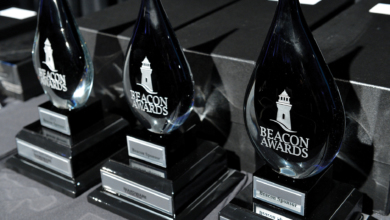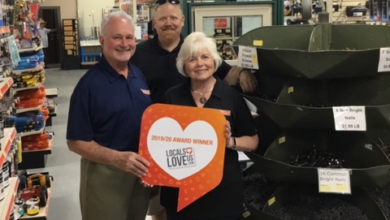Restoring Hope & Prosperity to a Dying But Resilient Town

Click to watch a video on Bantly Hardware’s story
Every time the city of Johnstown, Pa., reached a period of prosperity, a major flood wiped away progress. The steel and coal industries used to drive prosperity—at one time, Johnstown produced more steel than Pittsburgh—but the decline in those industries over the 20th century had robbed the city of its hope as jobs evaporated, poverty levels rose and the population dropped year after year.
With the city facing a bleak economic future, disaster struck on July 19, 1977, in a way that seemed to erase all hope of saving Johnstown. Eleven inches of rain fell in less than nine hours, causing a flash flood that led six dams to fail. More than 128 million gallons of water began rushing down the Conemaugh Valley, making it look like an atomic bomb had been dropped down on the town.
Rob Bantly, the fifth-generation owner of Bantly Hardware in Johnstown, was in bed when he got the call late that night—water was coming out the front door of the store.
“A flood had never hit that bad in our store before. I got out just before the door crashed in,” he recalls. “We spent the rest of the night trying to help other people.”

It represented the third major flood in Johnstown’s history, causing 84 deaths and $424 million in damage. The National Weather Service said that amount of rain was a once-every-10,000-years occurrence.
For Bantly Hardware, the future seemed bleak since they did not have flood insurance. “There was only one house in our borough that had flood insurance. Everyone was wiped out,” says Bantly, whose father Robert and uncle Chalmer owned the business then. “We never considered going somewhere else and starting over.”
They ended up losing five buildings in the flood. “We spent many weeks shoveling mud. We ended up getting $1,600 from an auction of what was salvageable,” says Bantly.
“The town was devastated. That flood in 1977 is what started the steel mills going down,” he adds. “Many businesses did not reopen and the city population almost immediately dropped 20 percent.”
The family took out a $160,000 loan to start over, but it was not nearly enough money to rebuild an entire business from scratch. “We were undercapitalized for a very long time,” says Bantly, who winces at the painful memory of those lean years.
While Bantly Hardware’s employees were able to get unemployment, the Bantly family had to rely on an insulation business that provided some money while the store remained closed. They reopened for business on September 21, 1978, after being closed for 429 days.
“Fifty years ago there were 13 hardware stores in town. We’re the only one left,” says Bantly. Most of those other stores were up on the hills that surround the city center and were insulated from the flood damage. Those businesses were able to profit from the months and years of rebuilding that took place, but they didn’t have Rob Bantly’s knack for perseverance. He was playing a long game.
Bantly Hardware was founded by Rob’s great-great-grandfather, Gottleib Bantly, in 1861, making it a member of The Hardware Connection Century Club. It is the second-oldest hardware store in Pennsylvania. Moxham Lumber Company, another Century Club retailer that dates back to 1907, also survived the flood and is the sole remaining independent lumberyard in Johnstown.

Rob worked in the store throughout his teen years, then joined the U.S. Navy as an electronics tech and air sea rescue swimmer. After a short stint working for an industrial wholesaler, he joined the business full time in 1971 at the age of 24, earning $75 per week.
Long Road to Recovery
Bantly’s grandfather, Milton Bantly, had been extremely successful as a third-generation owner of the business, but Bantly’s father and uncle didn’t have the same touch when they took over in 1956. “They got into boat manufacturing, making 500 fiberglass boats but losing money at it,” he recalls.
The building that was used for the boat showroom was wiped out by the flood, so that was the end of the boat business. The store had no parking lot for customers, but it did have a family member who had a burning desire to return the business to prosperity.
Bantly bought the business from his father and uncle in 1981—he was 34 years old. “I guaranteed the loan they had taken out. I had to put in $15,600 in goodwill to balance it out. I paid $765 a month for 30 years, but I paid back every dime,” he says proudly, while sitting in an office that contains a century of mementos of a resilient business.
Although he must have felt like Sisyphus having to roll the immense boulder up the hill, unlike Sisyphus, Bantly made it to the top of the hill.
Sales stayed pretty consistent once the store reopened, but those were hard-earned dollars. “We were doing $300,000 to $350,000 a year throughout the 1980s. It was a struggle throughout the ‘80s and ‘90s. I had no money to put into inventory,” he recalls.
Sales were still just $389,049 in 2002. Walmart came to town in 2003, but Bantly grew sales 28 percent that year. Also that year, the U.S. Census reported that Johnstown was the U.S. city least likely to attract newcomers.
Sales were flat in 2005, but otherwise have risen every year since, most years by double digits.
Lowe’s came to town around 2008, followed by Home Depot in 2010 or 2011. Bantly didn’t flinch at the new competition, having already survived his toughest challenge, but there were a number of low points.
“I was working long hours, six days a week,” he recalls. “Shortly after Depot came to town, a customer came in and said, ‘When are you quitting?’ And I replied, ‘The day after Depot closes.’”
He adds, “My wife was a teacher at a Christian school that paid very little. For a while I fixed up and flipped houses on the side. I bought an 1861 house (built the same year the business opened) and took 10 years to fix it up and then sold it for $227,000. I took the money from that and put it into the hardware store. We were so undercapitalized for so long.”
From 2006 to 2015, sales grew 371 percent at Bantly Hardware. The store hit $1 million in sales for the first time in 2010.
More importantly, Bantly learned he could compete and thrive in the face of big-box competition. “Now Depot and Lowe’s send customers to us every day,” he points out.
Other local stores have closed due to the boxes, so Bantly bought their inventory. “I did that with three stores for about 10 cents on the dollar. They were good deals, but that’s very labor intensive,” he says.
Flood City
Gottleib Bantly started the business at 121 Clinton Street in 1861, when Johnstown’s population was under 10,000. His greatest accomplishment was surviving the Great Flood of 1889, the first of three major floods that have earned Johnstown the moniker of “Flood City.”
With a canal system and a major stop for the Pennsylvania Railroad, Johnstown served as a central site for transporting goods across the state to Pittsburgh, 67 miles to the west. Iron, steel and coal became big business when the Second Industrial Revolution kicked off in 1870, and Johnstown was at the center of manufacturing activity.
Cambria Iron Company, founded in Johnstown in 1852, was the nation’s largest steel foundry in the 1870s and Johnstown was also the country’s leading producer of barbed wire.
When the South Fork Dam broke on May 31, 1889—14 miles upstream from Johnstown—the water had nowhere to go but down the valley and into the town. In the end, 2,209 people perished out of a population of nearly 30,000. That was greatest civilian loss in a single day in U.S. history until the terrorist attacks on September 11, 2001.
Helping Johnstown recover was the recently formed American Red Cross, which was spearheading its first major peacetime U.S. relief effort. News coverage of that relief effort helped establish the American Red Cross as the major disaster relief organization for a growing nation.
Johnstown recovered slowly from that devastating flood, growing to become the ninth most populous city in Pennsylvania in 1920. The city’s population reached a high of nearly 70,000 in the 1920s before the Great Depression hit.
The second major flood hit Johnstown in 1936, when 24 people died. President Franklin Delano Roosevelt pledged money to ensure Johnstown never flooded again, and the U.S. Army Corps of Engineers spent five years encasing the river banks in steel and concrete. Johnstown residents were reassured that they had seen their last major flood, which proved true for 35 years.
The Bantly family continued to make a name for itself in the hardware industry. After Gottleib had some initial success, at least four and possibly six of his brothers came over from Germany and opened hardware stores in Pennsylvania and St. Louis. Slowly over time they all closed.
Forging a New Identity
Bantly Hardware began buying from American Hardware Supply in 1920, which had moved to Butler, Pa., outside Pittsburgh, in 1960. When that company launched the ServiStar marketing program as a voluntary chain of owner-dealers in 1977, shortly after the flood, Bantly Hardware signed up as the second ServiStar store in the country.
As Bantly recalls, “Ace wanted to expand in Pennsylvania in 1990, so we started buying a few things from them. We’d been with American Hardware and ServiStar for 70 years, but they told us we had one week to drop Ace or they would drop us. After being a customer for 70 years that was not appreciated, so we went with Ace after that.”
In 1992, Bantly heard a new Ace executive named John Venhuizen give a presentation on how to compete against the boxes. “It was very helpful,” he notes.
Bantly adds, “We’re not branded Ace, because our brand is Bantly Hardware and it dates back over 150 years. Also, I don’t want to give up my J3 POS system, which we’ve had since 1999. But there’s no doubt that if I hadn’t joined Ace in the 1990s, we wouldn’t still be here.”
The 8,000-square-foot store has 64,000 SKUs and all are in the POS system. About 3,000 square feet are devoted to a backroom plumbing department, which alone generated over $1 million in sales last year.
“We have twice as many pipe fittings as Depot or Lowe’s,” Bantly points out, adding that commercial plumbers are his main customers. The store gets 35 percent of sales from walk-in retail business.
Bantly picked up more commercial/industrial business in the 1990s and is now up to 800 accounts. “We stock ignition transformers for oil boilers,” he notes, “A customer told me we needed to stock oil nozzles and I discovered there are 300 different types—so we stock and sell 150 of them. Customers come from all over to buy those. I’ve told our employees if we need something just order it.”
As the business has grown, space has been better utilized. Bantly moved his main showroom to the back, so he could put in a front parking lot where a house they owned had stood. Another 2,000 square feet was later added to the side. Recently, he moved a 5,000-square-foot warehouse across the street.
A year ago, Bantly bought a house out of foreclosure for $15,000. Located across the street from the store, it now serves as a 1,000-square-foot fireplace showroom. “That has been very successful. We doubled sales for fireplaces last year with the new shop,” he notes.
The store has 14 employees and only two are part time. Bantly’s sister Karen, who serves as manager, has been there 35 years. His grandson Ryan, who is 24, works full time and is a possible successor to the family legacy.
“My daughters are registered nurses. They would like to see the business continue, but they’re not going to take over. My biggest concern is being able to keep the service levels up,” Bantly says.
Finding and keeping good employees remains his biggest challenge, since Bantly lost three key employees this year. “One is a brilliant kid who is going to college for supply chain management. Another young guy worked here 10 years and is going to be a police officer. I know I’m paying above average wage for this town, so I don’t know what else to do,” he says.
Bantly hired the manager of cashiers at Depot, who has been with him one year. He also hired a guy who spent 20 years in the U.S. Navy on submarines. “He came here because he wants to make a difference and is very community oriented,” he explains.
While Bantly worries about his staffing, those worries pale in comparison to wondering how the store would survive after the flood washed away their dreams. “Everything is paid for and we have no debt. I bought a new truck for cash last year,” he says proudly.
Although he has never considered opening a second store, there was one time that Bantly considered selling the business. “I’ve had multiple offers to sell, but I’ve always said I’m not interested, except for one time. I had someone approach me about buying, but he needed enough funds to also pay off the loan and that was too much for him,” he says. “Now I’m glad that didn’t work out. I’m 72 years old, but I’m not ready to quit.”
Sales were a record $2.31 million in 2018, up 3 percent from the prior year. Sales are on track to rise another 3-4 percent this year, according to Bantly. “I stopped advertising in January, because we couldn’t keep up with the business we were getting,” he says.
“Johnstown is not growing, but some people are coming back or staying. The future is looking brighter,” according to Bantly.
In good times and bad, Bantly Hardware has always had strong involvement in the Johnstown community, supporting at least one project a month. Bantly donates or raises money for a backpack program for school kids, the K-9 police unit, a mountain bike trail, local food bank, the downtown business alliance, Sandyvale Memorial Gardens and Conservancy, the Hornerstown community garden and more.
Sign of the Times
In 2004, the city was tearing down a five-story building that had once housed Swank Hardware—which had bought one of the Bantly Hardware stores in 1902—and they discovered a sign made to look like a saw that said G. Bantly Hardware. “It had originally been in my uncle’s store and had been in the attic for over 100 years,” Bantly says.
That saw sign was restored and is now positioned outside the front entrance to Bantly Hardware, a fitting tribute to a business steeped in survival against the odds.
Another sign tells an even better story. Positioned on the sales floor by antique tools and historical photos, it features the Bantly Hardware name and shows the high-water mark during the flood of 1977—five feet, three inches. While it stands as a cautionary tale to guard against overconfidence, the sign is also a symbol of perseverance and resilience, for both a retailer and a town that have more experience than most at overcoming the raging floodwaters of adversity.
Johnstown Seeks a Brighter Tomorrow
Johnstown saw a steady decline in population after World War II from 63,232 in 1950 to 42,476 in 1970 and 28,134 in 1990. It was down to 19,447 in 2018—1,410 of them are veterans. “We’ve lost 70 percent of our population over the last century,” points out Rob Bantly, owner of Bantly Hardware.
The 1977 flood impacted industry, but so did new EPA regulations and increased domestic and foreign competition. Steel production in the area had all but dried up by the early 1990s.
The city of Johnstown, which owes $22 million in pensions, has been bankrupt for 30 years, according to Bantly. “We’re labeled the poorest town in Pennsylvania. You can buy a house for $2,000. We have a thousand houses around town that have been abandoned and are slated to be torn down.”
Johnstown’s poverty rate of 37.9 percent is more than double the state average. The median household income is $23,636, while the owner-occupied housing rate was 46.7 percent in 2017.
Bantly believes Johnstown has finally bottomed out and the city is now heading in a positive direction. “They are trying to turn the area into a tourist destination,” he says.
Flight 93 National Memorial, where the plane went down on 9-11, is 25 miles away in Stoystown. A boat launch is being built by Stonycreek River. Rivers that used to be filled with acid rain (due to the coal industry), are now turning into prime fishing spots. Whitewater rafting and bike trails are attracting visitors interested in recreation.
The unemployment rate, which was at 10 percent in 2010, was down to 4.9 percent in August 2019 (seasonally adjusted) as jobs have slowly returned.
Intuit recently put in a call center for Turbo Tax, with up to 200 employees. Intuit is also helping Wise, Va., with their “Mission Hope” project that has brought 900 jobs to two communities. Intuit brought its Prosperity Hub to Johnstown, which gives residents access to an innovation lab to learn new skills.
“We still have a wire mill that is one of the biggest in the U.S. and still going good, and there’s a plant downtown starting to make steel again,” Bantly points out.
A wind turbine blade manufacturing plant came to town in 2006, while Lockheed Martin relocated a plant to Johnstown in 2008. The high-tech defense industry is now well-represented in the area, along with health care.
Johnstown’s Vision 2025 is a group of young professionals that have a plan to revitalize downtown using a collaborative, community-driven approach. “I can see them succeeding. These are people that grew up here and care about what happens,” Bantly says.
A documentary, The Johnstown Flood, won the Academy Award for Best Documentary in 1989. It plays in an hourly loop at the Johnstown Flood Museum. Long-time Johnstown residents don’t need to view the film, because they still have vivid memories of the day the raging waters came crashing into their lives.
Johnstown now has an early warning system and reconstructed dams, but residents know better than to think they are safe forever.







